 HOME—BSA Handbooks & Handbook Covers—Scout Handbook—1st & 2nd Editions
HOME—BSA Handbooks & Handbook Covers—Scout Handbook—1st & 2nd Editions
The Scout Handbook, 1910-Today (continued)
1st & 2nd Editions—The Official Handbook for Boys (1911-1927)
1st Edition cover artwork by Gordon Grant, line drawing of a Scout in front of a campsite waving his campaign hat, beckoning to the reader. Printings 1-3 had an olive drab background, and the 2nd printing reprint plus printings 4-10 had a maroon background. There apparently were also some "special" printings with orange or light green covers. All back covers were the same color as the front, with a First Class badge.
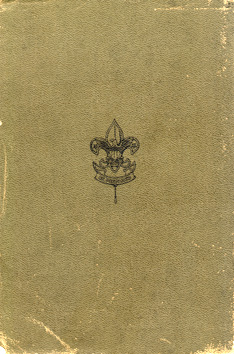
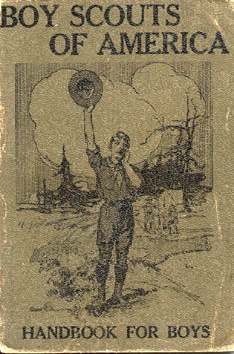
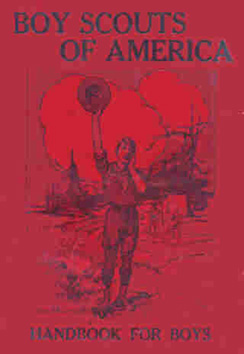
2nd Edition cover artwork (below) by J. C. Leyendecker, painting of a pair of Scouts (wearing red neckerchiefs) signaling in semaphore. The original picture was a Saturday Evening Post magazine cover (donated to the BSA) and had the Scouts using Morse code flags to send a non-existent semaphore letter. In 1916, BSA artists reversed the painting, which changed the non-existent semaphore letter to an 'L', and also placed the patrol colors on the right shoulder. In 1921, BSA artists changed the Morse flags to semaphore, removed the diamond pattern from the top of the Scout's socks, and updated some of the equipment worn by the Scouts. This Edition's 27 printings use five different cover colors.
Cover Versions:
- original painting (printings 11-14, all covers grey [below, top row left])
- second version (printings 15-23; pr.15/rose cover, pr.16/red cover [below, top row middle], pr.17-22/pale green cover [below, top row right], pr.23/olive cover)
- third version (printings 24-37, all covers olive [below, bottom row])
Back covers were the same color as the front cover. Through the 23rd printing, the back cover was blank; from the 24th printing on, the back cover had a United States Bicycle Tire ad.
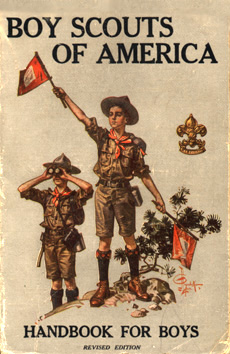
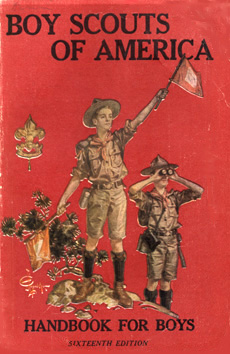
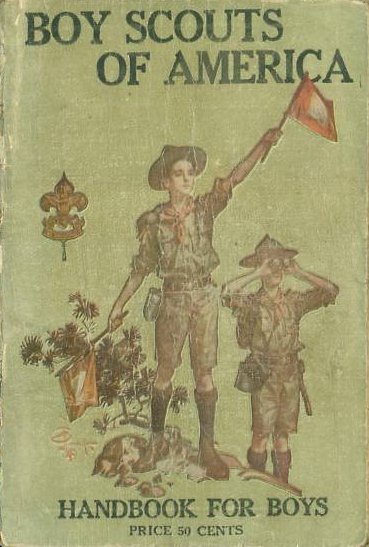
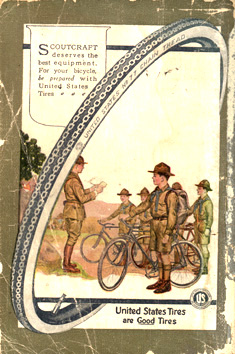
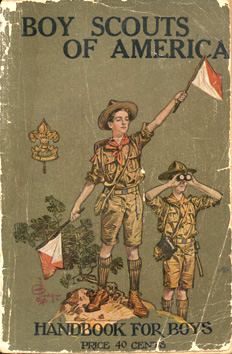
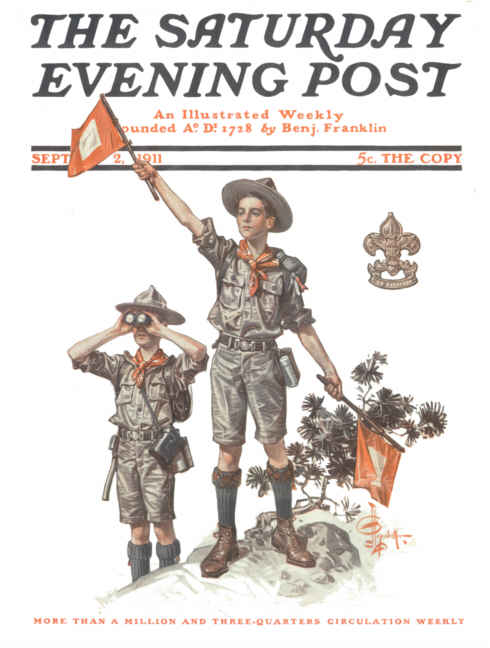
The 1st Edition reflected the newly-standardized American program. Although an improvement on the Original Edition, the 1st Edition contains many weak descriptions and errors, and it shows a lack of logical organization. Ernest Thompson Seton had expected to write the 1st Edition, but BSA's leadership preferred to put the book in the hands of an Editorial Board that more closely followed the developing BSA policies and practices.
The publicity surrounding the introduction of the new Handbook showed the effective promotional skills of Chief Scout Executive West. In June, 1911, he took the unprecedented step of sending out 4500 proof copies to educators for comment. Since the Handbook was published two months later, it is doubtful that the BSA received any significant amount of feedback in time to change the galleys, but the exercise was effective in promoting the book and the young Scouting organization.
The 1st Edition is illustrated both with line drawings and with many poorly-reproduced black-and-white photographs. In the 2nd Edition, line drawings were made from the photographs. No other Handbook until the 10th Edition has used photographs (though all editions of the Scoutmaster Handbook used photographs until 1972).
Comparing a number of printings of these two editions shows the long-time BSA policy of making gradual revisions, corrections, additions, and deletions. The successive printings change only gradually; at no time can one say that a major change has occurred. Many changes were made with printing 11 (1914), but the greatest change in content occurred with printing 14 (1916), when all of the many sections written by BSA co-founder Ernest Thompson Seton were removed. (The subjects remained in the Handbook, usually in the same order and with the same chapter titles; they were rewritten by different authors.)
The 1st Edition omits a number of standard Scouting topics: map & compass, conservation, poison plants, knife & axe, description of troop leader positions, the Scout Handclasp, when to wear the uniform. All of these were added in the 2nd Edition. The omission of knife and axe seems particularly careless since the Handbook lists proper use of knife and axe as a Second Class requirement. Although Seton's Original Edition had recommended the international left-handed Scout handclasp invented by Baden-Powell, the BSA chose to invent their own (left handed, but with three fingers instead of the full hand), which the 2nd Edition shows. [The BSA did not change to the international handclasp until 1972.]
Although poisonous snakebites in the US are rare and seldom fatal (many more people die from bee stings each year), the Scout Handbook has always discussed their treatment. The 1st and 2nd Editions contain two separate and contradictory treatments, one in the section describing reptiles and the other in the first aid section (each section was written by a different expert). Both explanations are vaguely written, and the recommended treatments were probably more dangerous to the victim than the actual bite.
Both editions evidence considerable carelessness in preparation, and most of the problems were never corrected through 42 printings over 16 years. One example is the contradictory treatments for poisonous snakebite. Another is contradictory information about coffee. The index has two references under coffee. One tells the Scout not to drink coffee at all ("Growing boys especially should have nothing to do with tea, coffee, or any stimulant") while the other tells the Scout exactly how to prepare coffee while out on the trail.
The US history section contains several factual errors about the Mexican War. One date is wrong by a year, the books stretch the war from two years to three, and the sequence of key war events is reversed.
Throughout these editions, the editors seem to have paid scant attention to any logical sequencing or arrangement of the subjects, and they exercised little editorial control over individual authors. For example, the books cover first aid skills in a haphazard order, with minor and major problems intermixed. Perhaps this general carelessness is best summed up by looking at the most obvious part of the 2nd Edition, the cover. The original Leyendecker painting (which first appeared as a Saturday Evening Post cover) contains several errors. The Scout is sending a non-existent semaphore letter (of the 28 possible semaphore arm positions, Leyendecker had the bad luck to pick one of only two that do not signify a letter in English-language semaphore). Also, the Scouts' patrol colors are on the wrong sleeve, the Scout badge is missing the knot hanging from the scroll, and the signal flags are Morse rather than semaphore flags. After five printings, the BSA corrected all but the last error in 1916 by the expedient of reversing the picture (even though this meant the Scouts' shirts and flies would be buttoned backwards). The Morse flags were changed to semaphore in 1921, after 14 printings.
Although the Original Edition contains the modern International (Continental) Morse code, the 1st Edition contains only the already-obsolete American (Overland) Morse code. The 2nd Edition restores the International version. Other types of signaling covered in these editions are Myer code (a form of wigwag), Indian signs (written signs), and Ardois (a system using four red and white lights), also whistle signals and bugle calls.
Early printings taught a Scout not only how to build a radio receiver, but also how to make a sending unit (radio was an exciting new invention at this time). The 1st Edition contains instructions on how to find one's latitude using the North Star. Unfortunately, even an adult would have difficulty following the explanation (written by Seton) found in early printings; it is sloppy writing and takes too much for granted. Later printings contain a much improved explanation by a different author. On the other hand, Seton's discussion of wild animals is much more modern and neutral than that of his conservation successor, William Hornaday. Although Hornaday was in the forefront of the conservation movement in his day and advocated absolute protection for "valuable" animals, he showed a disregard for the potential extinction of "pest" animals. For example, he refers to the coyote as a "petty thief" and writes that "the Coyote simply will not give up, and so the war upon him must be unceasing." Hornaday also condoned the extermination of the gray wolf.
Right from the start, Scouting led most other youth organizations in recognizing that puberty is a major hurdle for adolescents. But the early Handbooks provided information that was too often just as inaccurate as what a boy might hear from his buddies. The first three editions call their puberty section "Conservation", and primarily serve up the myth that masturbation (they of course do not use this word) will seriously weaken a boy's strength and make him less able to resist disease (hence the title "Conservation"). The word "puberty" has yet to appear in any Scout Handbook (although several later editions do use the terms "masturbation" and "nocturnal emission or wet dream"). The first two editions do not discuss wet dreams. They refer to the sex act (and its undesirability before marriage) only in the most roundabout way.
Under "Outdoor Athletic Standards" in the 1st Edition, the books gives recommendations for standards in various events, based on a boy's weight (a boy under 125 pounds should be able to do 13 pushups and run 100 yards in 13 seconds). It is a little amusing that the book recommends that boys under 110 pounds "should not attempt" the 100-yard dash, and that boys under 90 pounds "should not attempt" pushups either.
1st & 2nd Editions Summary and Printing History
Combined Total for 1st/2nd Editions
As evidenced by the continuous numbering of the official printings, these two "Editions" are truly a single book.
- 1911-1927 (16 years)
- 2,923,971 copies printed (average 182,748 copies printed per year)
- about 42 printings
1st Edition
- title from title page—The Official Handbook for Boys
- by BSA Editorial Board & various experts
- cover art by Gordon Grant
- 1911-1914 (3 years)
- 313,500 copies printed (average 104,500 copies printed per year)
- size 124x184x19 mm (4-7/8x7-1/4x3/4")
- 13 printings (called "editions" in the Handbooks; BSA records identify 10 "regular" printings plus a "reprint" of the 2nd printing; in addition, there are two other printing variants known):
—1st printing (Aug 1911, 40 000 copies)—olive drab cover, 400 numbered pages, 1911 on title page
—2nd printing (Nov 1911, 60 000 copies)—olive drab cover, 404 numbered pages, 1911 on title page
—2nd printing reprint (Dec 1911, 5250 copies)—maroon cover, 404 numbered pages, 1911 on title page
—3rd printing (May 1912, 25 500 copies)—olive drab cover, 404 numbered pages, 1912 on title page
—4th printing (Jul 1912, 26 000 copies)—maroon cover, 404 numbered pages, 1912 on title page (no edition identified)
—5th printing (Jan 1913, 27 250 copies)—maroon cover, 404 numbered pages, title page says Fourth Edition and 1912
—6th printing (May 1913, 25 000 copies)—maroon cover, 404 numbered pages, title page says Fourth Edition and 1913
—7th printing (Oct 1913, 25 000 copies)—maroon cover, 416 numbered pages, title page says Fourth Edition and 1913, no ads
—8th printing (Dec 1913, 24 500 copies)—maroon cover, 416 numbered pages, title page says Fourth Edition and 1913, Eisner ads on both inside covers
—first "special" printing (?? 1913, ?? copies [rare])—orange cover, 416 numbered pages, title page says Fourth Edition and 1913, no ads
—second "special" printing (?? 1913, ?? copies [very rare])—light green cover, 416 numbered pages, title page says Fourth Edition and 1913, no ads
—9th printing (Feb 1914, 25 500 copies)—maroon cover, 440 numbered pages, 1914 on title page
—10th printing (Mar 1914, 25 000 copies)—maroon cover, 440 numbered pages, 1914 on title page; in reality, a reprint of the 9th printing, identical in every way
2nd Edition
- continuation of 1st Edition
- cover art by J. C. Leyendecker
- 1914-1927 (13 years)
- 2,610,471 copies printed (average 200,805 copies printed per year)
- size 121x184x16 mm (4-3/4x7-1/4x5/8") [early printings]
- size 121x178x16 mm (4-3/4x7x5/8") [later printings]
- 29 printings (called "editions" until the 33rd printing; numbering of printings continued from the previous edition, from 11 through 37; BSA records identify 27 "regular" printings plus a "reprint" of the 13th printing; in addtion, there was a special reprint of the 18th printing, apparently in error):
—11th printing (1st pr of 2nd Ed) (Oct 1914, 50 000 copies)—grey cover, 472 numbered pages, Eleventh Edition and 1914 on title page
—12th printing (2nd pr of 2nd Ed) (Jan 1915, 18 000 copies)—grey cover, 472 numbered pages, Twelfth Edition and 1914 on title page
—13th printing (3rd pr of 2nd Ed) (Mar 1915, 100 000 copies)—grey cover, 464 numbered pages, Thirteenth Edition and 1915 on title page
—13th printing reprint (3rd pr reprint of 2nd Ed) (Apr 1916, 15 000 copies)—grey cover, 464 numbered pages, Thirteenth Edition and 1916 on title page
—14th printing (4th pr of 2nd Ed) (Jun 1916, 100 000 copies)—grey cover, 498 numbered pages, Fourteenth Edition and 1916 on title page
—15th printing (5th pr of 2nd Ed) (Dec 1916, 100 000 copies)—rose cover, 498 numbered pages, Fifteenth Edition and 1916 on title page; cover has been reversed to correct the semaphore letter and to get the patrol colors on the right sleeve, and a knot has been added to the scroll on the Scout badge
—16th printing (6th pr of 2nd Ed) (May 1917, 100 000 copies)—red cover, 498 numbered pages, Sixteenth Edition and 1917 on title page
—17th printing (7th pr of 2nd Ed) (Dec 1917, 100 000 copies)—pale green cover, 498 numbered pages, Seventeenth Edition on title page
—18th printing (8th pr of 2nd Ed) (May 1918, 100 000 copies)—pale green cover, 498 numbered pages, Eighteenth Edition on title page
—18th printing reprint (8th pr reprint of 2nd Ed) (Dec 1918, apparently an error on the title page, corrected partway through the printing run, total of 100 000 copies for both 18th printing reprint and 19th printing)—pale green cover, 496 numbered pages, Eighteenth Edition Reprint on title page
—19th printing (9th pr of 2nd Ed) (Dec 1918, see 18th printing reprint)—pale green cover, 496 numbered pages, Nineteenth Edition on title page
—20th printing (10th pr of 2nd Ed) (May 1919, 100 000 copies)—pale green cover, 496 numbered pages, Twentieth Edition on title page
—21st printing (11th pr of 2nd Ed) (Dec 1919, 100 000 copies)—pale green cover, 496 numbered pages, Twentyfirst Edition on title page
—22nd printing (12th pr of 2nd Ed) (Jun 1920, 100 000 copies)—pale green cover, 492 numbered pages, Twentysecond Edition on title page
—23rd printing (13th pr of 2nd Ed) (Jan 1921, 100 000 copies)—olive green cover, 488 numbered pages, Twentythird Edition on title page
—24th printing (14th pr of 2nd Ed) (Jun 1921, 100 000 copies)—olive green cover, 488 numbered pages, Twentyfourth Edition on title page; cover signal flags changed to semaphore style; at least two cover variants exist with different type fonts for the title
—25th printing (15th pr of 2nd Ed) (Feb 1922, 100 000 copies)—olive green cover, 512 numbered pages, Twentyfifth Edition on title page
—26th printing (16th pr of 2nd Ed) (Aug 1922, 100 000 copies)—olive green cover, 512 numbered pages, Twentysixth Edition on title page
—27th printing (17th pr of 2nd Ed) (Apr 1923, 112 000 copies as corrected in May 1924)—olive green cover, 512 numbered pages, Twentyseventh Edition on title page
—28th printing (18th pr of 2nd Ed) (Sep 1923 [this printing says May 1923, but the May 1924 Handbook corrects this to Sep 1923], 98 700 copies as corrected in May 1924)—olive green cover, 512 numbered pages, Twentyeighth Edition on title page
—29th printing (19th pr of 2nd Ed) (Jan 1924 [this printing says Dec 1923, but the May 1924 Handbook corrects this to Jan 1924], 111 398 copies as corrected in May 1924)—olive green cover, 512 numbered pages, Twentyninth Edition on title page
—30th printing (20th pr of 2nd Ed) (May 1924, 105 373 copies as corrected in Jan 1925)—olive green cover, 512 numbered pages, Thirtieth Edition on title page
—31st printing (21st pr of 2nd Ed) (Jan 1925, 100 000 copies)—olive green cover, 512 numbered pages, Thirtyfirst Edition on title page
—32nd printing (22nd pr of 2nd Ed) (May 1925, 100 000 copies)—olive green cover, 512 numbered pages, Thirtysecond Edition on title page
—33rd printing (23rd pr of 2nd Ed) (Aug 1925, 100 000 copies)—olive green cover, 512 numbered pages, Thirtythird Printing on title page
—34th printing (24th pr of 2nd Ed) (May 1926, 100 000 copies)—olive green cover, 512 numbered pages, Thirtyfourth Printing on title page
—35th printing (25th pr of 2nd Ed) (Jul 1926, 100 000 copies)—olive green cover, 512 numbered pages, Thirtyfifth Printing on title page; several variants with different ads inside
—36th printing (26th pr of 2nd Ed) (Mar 1927, 100 000 copies)—olive green cover, 516 numbered pages, Thirtysixth Printing on title page
—37th printing (27th pr of 2nd Ed) (May 1927, 100 000 copies)—olive green cover, 512 numbered pages, Thirtyseventh Printing on title page
Actual 1st & 2nd Editions Table of Contents
1st & Early 2nd Editions
- Chapter I—Scoutcraft
Aim of Scout Movement
What Scouting Means
Scout Virtues [later changed to "Things Scouts Must Know"]
How to Become a Scout [added to table of contents in later printings, but already present in book]
The Boy Scout Organization
Scout Oath
Scout Law
Tenderfoot, Second Class, and First Class Scout Requirements
Badges, Awards and Equipment [replaced in later printings by following two sections]
Merit Badges [added in later printings]
Badges and Awards [added in later printings]
Knots Every Scout Should Know
The Compass [added in later printings]
- Chapter II—Woodcraft
Woodlore
Birdcraft
Shells and Shellfish
Reptiles
Insects and Butterflies
Fishes and Angling
Aquarium
Rocks and Pebbles
Flowers, Ferns, and Grasses
Mushrooms, Fungi or Toadstools
Common North American Trees
Native Wild Animals
Conservation [added in later printings]
- Chapter III—Campcraft
Hiking and Over-Night Camps
Tent Making Made Easy
An Open Outing Tent
Canoeing, Rowing, and Sailing
- Chapter IV—Tracks, Trailing, and Signaling
- Chapter V—Health and Endurance
- Chapter VI—Chivalry
- Chapter VII—First Aid and Life Saving
Water Accidents
Bandaging [added in later printings]
- Chapter VIII—Games and Athletic Standards [changed to "Games" in later printings]
Indoor and Outdoor Games
Athletic Standards [removed in later printings]
- Chapter IX—Patriotism and Citizenship
Practical Citizenship
- Appendix
Equipment [removed in later printings]
Books for Reference
Every Boy's Library [added in later printings]
General Reading [added in later printings]
Merit Badge Books and Others [added in later printings]
Index
Advertisements [removed in later printings]
Later 2nd Editions
- Chapter I—Scoutcraft
Aim of Scout Movement
What Scouting Means
Things Scouts Must Know
How to Become a Scout
The Boy Scout Organization
Scout Motto [added to table of contents in later printings, already present in book]
Scout Badge [added to table of contents in later printings, already present in book]
Scout Oath
Scout Law
Scout Oath and Law [replaced previous two sections in later printings]
Tenderfoot, Second-Class, and First-Class Scout Requirements
Merit Badges
Badges and Awards
Knots Every Scout Should Know
The Compass
Instructions in Map Reading and Map Making [added in later printings]
- Chapter II—Woodcraft
Woodlore
How to Build a Log Cabin
Measuring Heights and Distances
How to Find Your Latitude by the Stars
What to Do if Lost
How to Make Fire Without Matches
Archery
The Stars
Bird Study
Mollusca—Shells and Shellfish
Reptiles
Insects and Butterflies
Fishes and Angling
Aquarium
Rocks and Pebbles
Plants, Ferns, and Grasses
Mushrooms and Some Other Common Fungi
Native Forest Trees
- Chapter III—Wild Life and Conservation
Wild Animals Every Scout Should Know
Conservation of Wild Life and Forests
- Chapter IV—Campcraft
Hiking and Over-Night Camp
Tent Making Made Easy
An Open Outing Tent
Canoeing, Rowing, and Sailing
- Chapter V—Signs, Symbols, and Signaling
Trail Marks, and Signaling
Radio and Wireless Telegraphy [added in later printings]
Wireless Telegraphy Apparatus [changed to "How to Make a Radio Receiver" in later printings]
- Chapter VI—Health and Endurance
- Chapter VII—Chivalry
- Chapter VIII—Prevention of Accidents, First Aid and Life Saving
Prevention of Water Accidents
Bandages
- Chapter IX—Games
- Chapter X—Patriotism and Citizenship
Practical Citizenship
- Appendix
Every Boy's Library [removed in later printings]
Extracts from Constitution and By-Laws [added in later printings]
Index


Last Revision to This Page: 18 January 2024
Text copyright © 1980, 1990, 1999 by Jeff Snowden
Web format © 1996-2024 by Troop 97 BSA
Handbook pictures copyright © by Boy Scouts of America
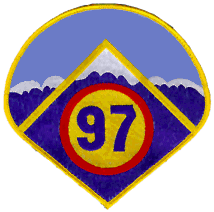
![]() HOME—BSA Handbooks & Handbook Covers—Scout Handbook—1st & 2nd Editions
HOME—BSA Handbooks & Handbook Covers—Scout Handbook—1st & 2nd Editions







